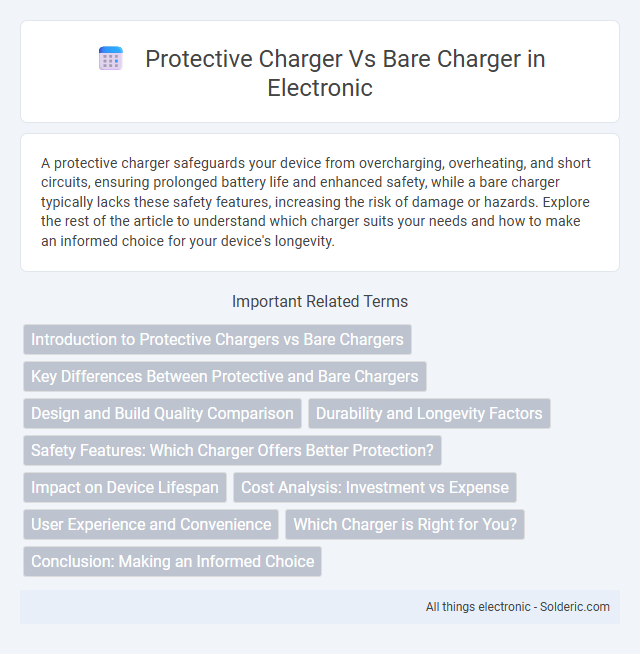A protective charger safeguards your device from overcharging, overheating, and short circuits, ensuring prolonged battery life and enhanced safety, while a bare charger typically lacks these safety features, increasing the risk of damage or hazards. Explore the rest of the article to understand which charger suits your needs and how to make an informed choice for your device's longevity.
Comparison Table
| Feature | Protective Charger | Bare Charger |
|---|---|---|
| Safety | Includes over-voltage, over-current, and short-circuit protection | No built-in safety features |
| Durability | Enhanced with protective casing and circuit safeguards | Exposed components, prone to damage |
| Cost | Higher cost due to additional protection features | Lower cost, basic functionality |
| Reliability | Stable performance with minimal risk of failure | Higher risk of malfunction and damage |
| Use Case | Ideal for consumer electronics requiring safe charging | Suitable for controlled environments or experimental setups |
Introduction to Protective Chargers vs Bare Chargers
Protective chargers feature built-in safety mechanisms such as overcharge protection, short circuit prevention, and temperature regulation, ensuring enhanced device longevity and user safety. Bare chargers, lacking these safeguards, directly transfer power without monitoring, increasing the risk of damage to connected devices. Choosing protective chargers significantly reduces electrical hazards compared to bare chargers, which are more prone to causing battery degradation and potential fire risks.
Key Differences Between Protective and Bare Chargers
Protective chargers feature built-in safeguards such as overcharge, short circuit, and temperature protection, ensuring safer and more reliable device charging compared to bare chargers that lack these safety components. Bare chargers provide basic power delivery without integrated protective circuits, increasing the risk of device damage or battery degradation. The inclusion of protective elements makes protective chargers ideal for extending battery lifespan and maintaining optimal device performance.
Design and Build Quality Comparison
Protective chargers feature reinforced casings made from durable materials such as ABS plastic or silicone, providing enhanced resistance to drops, impacts, and scratches compared to bare chargers that typically have minimal or no protective housing. The design of protective chargers often includes raised edges and non-slip grips to safeguard your device and improve handling, whereas bare chargers prioritize a lightweight, compact form factor without added durability. Choosing a protective charger ensures better longevity and physical security for your charging equipment in everyday use.
Durability and Longevity Factors
Protective chargers with reinforced casings and quality insulation materials exhibit significantly higher durability and longevity compared to bare chargers, which are more prone to physical damage and wear. The presence of overcharge protection, temperature control, and surge protection in protective chargers enhances their lifespan by preventing internal component degradation. Bare chargers often lack these safety features, leading to quicker failure and reduced operational life under regular usage conditions.
Safety Features: Which Charger Offers Better Protection?
Protective chargers offer better safety features compared to bare chargers due to built-in mechanisms such as overcharge protection, short circuit prevention, and temperature control. These features help safeguard your device from potential damage caused by power surges, overheating, and electrical faults. Choosing a protective charger significantly reduces the risk of battery degradation and enhances overall device longevity.
Impact on Device Lifespan
Using a protective charger significantly enhances device lifespan by regulating voltage and preventing overheating, which reduces battery wear and component stress. Bare chargers often lack advanced safety features, increasing the risk of voltage spikes, heat damage, and battery degradation. Consistent use of a protective charger ensures stable power supply, maintaining battery health and extending overall device longevity.
Cost Analysis: Investment vs Expense
Investing in a protective charger often involves a higher upfront cost but reduces long-term expenses by minimizing damage to your device and extending its lifespan. Bare chargers may seem cost-effective initially but can lead to frequent replacements and potential device repair costs due to lack of protection. Evaluating the total cost of ownership highlights that investing in a protective charger is a smarter financial decision for preserving your device's functionality.
User Experience and Convenience
Protective chargers offer enhanced user experience by providing durability and safeguarding against accidental drops, which minimizes downtime and replacement costs. Bare chargers, while often lighter and more compact, lack added protection, making them more susceptible to damage from daily wear and tear. The convenience of protective chargers comes from their robust design that extends lifespan and reduces the need for frequent replacements, benefiting users who prioritize reliability over minimal bulk.
Which Charger is Right for You?
Choosing between a protective charger and a bare charger depends on your device usage and environmental factors. Protective chargers offer enhanced durability with reinforced cables and casing, reducing the risk of damage from drops or frequent plugging, ideal for heavy users or outdoor environments. Bare chargers are typically lightweight and cost-effective, suitable for minimal use or controlled indoor settings where portability is a priority.
Conclusion: Making an Informed Choice
Choosing between a protective charger and a bare charger depends on prioritizing device safety and durability, as protective chargers feature reinforced cables and housing that reduce wear and prevent electrical hazards. Bare chargers, while often more compact and affordable, lack enhanced safety features and may be more susceptible to damage and short circuits over time. Consumers seeking long-term reliability and device protection should opt for protective chargers to minimize risks and ensure efficient charging performance.
protective charger vs bare charger Infographic

 solderic.com
solderic.com